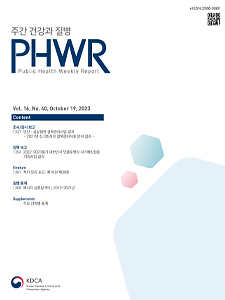Current Issue
Vol.16 No.40, October 19, 2023
-
Surveillance Reports 2023-10-19
 1
1
 773
773
 210
210
The Korean National Public-Private Mix Tuberculosis Control Project: Analysis of the Indicators for Tuberculosis Management in 2021
Chieeun Song, Jaetae Kim, Su Yeon Kim, Hoyong Choi, Jinsoo Min, Ju Sang Kim, Jae Seuk Park
Public Health Weekly Report 2023; 16(40): 1337-1353 https://doi.org/10.56786/PHWR.2023.16.40.1 Abstract
AbstractThe Korea Disease Control and Prevention Agency has been promoting a “Public-Private Mix Tuberculosis Control Project (PPM Project)” with the “Korean Academy of Tuberculosis and Respiratory Diseases” since 2011. In 2021, 182 PPM institutions participated in the PPM Project, and managed 82.1% of tuberculosis (TB) patients. This study analyzed 35 TB management indicators based on the reported data of TB patients from 182 institutions that participated in the PPM Project in 2021. The final treatment results were confirmed through five-quarter observation by dividing the reported date by quarters. The sputum smear test rate, sputum culture test rate, and sputum MTB PCR test rate reported by PPM institutions in 2021 were 95.9%, 95.6%, and 91.5%, respectively. The rapid drug susceptibility test rate was 87.7% in 2021, an increase from 66.5% in 2020. In 2021, the rates of treatment completion within 12 months, stopped, failure, and still on treatment were 76.5%, 2.3%, 0.06%, and 7.2%, respectively. The mortality rate was 14.0%. In 2021, the household contact investigation rates in adults and children were 92.0% and 93.0%, respectively, down from 94.5% and 94.4% in 2020. On the other hand, the treatment rates for latent TB infection were 74.1% and 95.1% in adults and children, respectively, an increase from the corresponding 69.3% and 91.9% in 2020. The rates of sputum smear tests and sputum culture tests for suspected TB patient among contacts were 47.7% and 42.9%, respectively. Since more than 80% of TB patients are managed by PPM institutions, quality control of PPM institutions is important.
-
Policy Notes 2023-10-19
 3
3
 2803
2803
 649
649
The Republic of Korea National Influenza Vaccination Project: Outcomes of the 2022–2023 Season
Seo-Hyeon Ahn, Seunghyun Lewis Kwon, Min-Ju Song, Seong-Su Jeon, Jae-Young Lee, Jin-Hee Park, Hyun-A Bae, Jae-Eun Lee, Hyung-Min Lee
Public Health Weekly Report 2023; 16(40): 1354-1366 https://doi.org/10.56786/PHWR.2023.16.40.2 Abstract
AbstractThe national influenza vaccinations program has implemented for the adults aged 65 years and older, pregnant women and children aged 6 months to 13 years. This article introduces the main results of the national influenza vaccination program for the 2022–2023 season. The vaccination rate of each target group was 81.9% for the older adults, an increase of 1.4%p from the previous year, and 50.4% and 71.0% for pregnant women and children, respectively (a decrease of 3.8%p and 2.8%p, respectively, from the previous year). A total of 118 reports of adverse reactions after influenza vaccination were reported, similar to the previous year. Based on the main results from the 2022–2023 season, it is expected to be used as baseline data for the development of national influenza vaccination in the future.
-
Erratum 2023-10-19
 0
0
 1072
1072
 385
385
Erratum : Volume 16. No 39.
Public Health Weekly Report 2023; 16(40): 1367-1367 https://doi.org/10.56786/PHWR.2023.16.40.3 -
QuickStats 2023-10-19
 0
0
 763
763
 402
402
Trends in the Intake of Energy, 2012-2021
Public Health Weekly Report 2023; 16(40): 1368-1369 https://doi.org/10.56786/PHWR.2023.16.40.4

pp. 1~2097
Most Keyword
?
What is Most Keyword?
- It is the most frequently used keyword in articles in this journal for the past two years.
Most Read
-
Waterborne and Foodborne Disease Outbreaks in the Republic of Korea, 2023
Myung-Jae Hwang, So Yeon Park, Hyungjun Kim, Se Jeong Yang, Sungchan Yang, Jin Seon Yang
Public Health Weekly Report 2025;18: 17-32 https://doi.org/10.56786/PHWR.2025.18.1.2 -
Implementation Plan for the Coronavirus Disease 2019 Vaccination for the 2024–2025 Season: Recommendations of the 6th Expert Committee on Immunization Practices
Hyewook Hwang, Wookeon Lee, Seohyeon Ahn, Young-Sook Choi, Seunghyun Lewis Kwon, Dongwoo Lee, Eun Hwa Choi, SokGoo Lee
Public Health Weekly Report 2025;18: 90-102 https://doi.org/10.56786/PHWR.2025.18.2.3
Editorial Office
+82-43-719-7569





 Full Text
Full Text Cite
Cite


